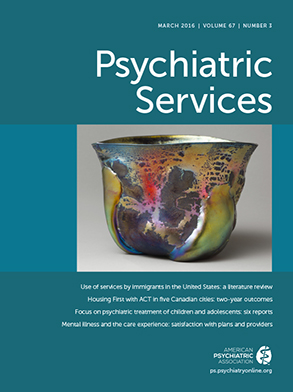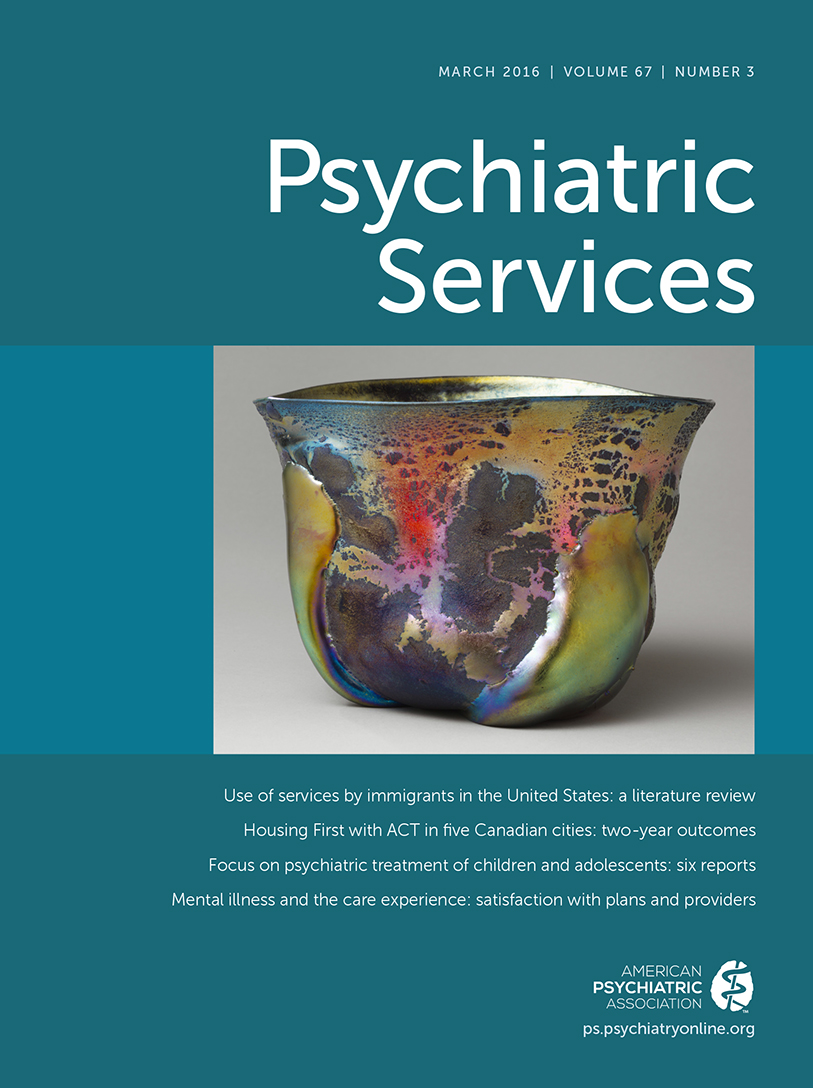Oregon State Hospital (OSH) was initially established as the Oregon State Insane Asylum, accepting its first patient on October 22, 1883. Like other state psychiatric hospitals, OSH has been the de facto last resort for the care of persons with severe mental illness. With deinstitutionalization, the OSH census dropped from a peak of more than 3,500 patients in 1958 to 635 in 2014 (
1). Recent years have seen a steady increase in forensic patients (insanity acquittees and those deemed not competent to stand trial) at OSH and a corresponding decrease in civilly committed patients. Today, most OSH beds (65%) are occupied by forensic patients, creating a need for more psychiatrists trained in navigating the intersection of the legal and mental health systems.
Providing adequate treatment in Oregon has been a challenge, and OSH has a history of chronic understaffing. In 1953, only 16 psychiatrists cared for 3,000 patients (
1). Currently, about 40 psychiatrists care for approximately 600 patients, and the hospital administration estimates that another ten psychiatrists would be required to reach full staffing levels.
Although physician burnout is a concern among psychiatrists in general (
2), the inherent stressors associated with a forensic environment, particularly the heightened potential for violence (
3), likely contribute to reluctance to work with this population. In addition, OSH is a one-hour commute from Portland, where many professionals prefer to live. The greater satisfaction and decreased burnout associated with academic duties, such as teaching and scholarship (
4), are lacking at OSH. Thus staff recruitment and retention have historically been difficult.
Theory and Implementation
There is a long history of successful collaboration between university psychiatry programs and public mental health systems (
5,
6). As early as 1896, Columbia University established the New York State Psychiatric Institute, one of the first institutions to incorporate teaching and research with the care of persons with mental illness (
6). These collaborations, as in the case of the state hospital system in Maryland and the University of Maryland, have been utilized as a strategy to improve working conditions for psychiatrists in the public sector and enhance recruitment and retention (
7). Such partnerships are also a means of improving the quality of care at public institutions and promoting research (
8). Their successes formed the groundwork for the Oregon collaboration.
In Oregon, the partnership between the state hospital system and Oregon Health and Science University (OHSU) dates to 1973, when psychiatry residents began to spend a portion of their training at one of the state hospitals—an arrangement that continues to this day (
9). In 2006, the U.S. Department of Justice CRIPA (Civil Rights of Institutionalized Persons Act) investigation of OSH raised several concerns, including the need to hire more staff and increase the standard of care (
10). The growing insanity acquittee population included many patients who were difficult to discharge, and there was a need for higher quality of forensic evaluations and more forensic expertise to optimize efficient use of the limited beds.
The collaboration between OHSU and OSH was envisioned as an innovative way to improve the quality of care by initially introducing psychiatrists from the OHSU Department of Psychiatry as consultants while also helping to fund the department. This plan required collaboration between key stakeholders at OHSU, the OSH leadership, and state government officials.
The concept of an OHSU-OSH relationship pleased the state legislature, which preferred taxpayer money to stay in state rather than going to out-of-state locum tenens agencies to fill vacancies. During the 2007 Oregon legislative session, state laws were changed allowing university-employed psychiatrists to work and hold supervisory positions at OSH. A barrier to creation of the partnership was the OSH physicians’ union, which was concerned that increasing coverage by non–state-employed physicians would weaken the union. Conversely, some at OHSU were not in favor of the partnership, considering OSH’s past reputation of providing suboptimal care.
A unique aspect of the arrangement is allowing forensically trained psychiatrists to rotate through the Forensic Evaluation Service (FES) for three months every year in lieu of direct clinical work. OSH created a forensic evaluation rotation to address the increased forensic workload while creating a valuable recruiting tool for the hospital. Recruitment of new physicians became a priority, and changes were made to attract physicians, such as streamlining the OSH credentialing process. In response to the CRIPA investigation, an attractive new hospital was opened in Salem in 2011. OHSU was also able to create a separate recruitment contract with the state that paid for applicants to visit and relocate to Oregon. Going forward, retention of psychiatrists at the state hospital remains a challenge, further complicated by the general shortage of psychiatrists nationally.
A Personal Account by Dr. Mobbs
The OHSU-OSH position was appealing to me given my desire to use my training in forensic psychiatry, practice in an academic environment, and work with individuals with severe mental illness. I work for three months of the year exclusively in the FES and for nine months on the forensic unit. The work week is divided into four clinical days and one academic day.
The FES staff consists mainly of forensically trained psychologists, and the department conducts most of the competency-to-stand-trial and criminal-responsibility assessments in the state. At any given time, one to three rotating forensic psychiatrists, along with one forensic psychiatry fellow, join this group. One of the major challenges for newly trained forensic psychiatrists is obtaining forensic cases in the first few years posttraining. This position enabled me to complete more than 30 forensic competency and insanity evaluations. I gained vital early-career experience completing forensic interviews, writing reports, and testifying in two high-profile homicide cases—arguably cases that I would not have obtained as a newly minted physician in a different job. I was able to testify during my regular work hours, whereas in other positions that I considered I would have been required to use my vacation time for testifying. Because OSH is a large institution, coverage was relatively easy to find, and with many forensically trained peers there was a clear understanding of the need for coverage.
My experience on the forensic unit has been a rich one. Treating patients with severe mental illnesses, as well as frequently co-occurring personality and substance use disorders, can be extremely challenging as well as rewarding. There is the added complexity of having patients involved in the legal system and with many external motives to malinger. My experience has hastened my development of firm boundaries and thoughtful documentation.
As for my academic experience, I am afforded an academic day, but I sometimes use it to complete clinical duties. Most OSH physicians have worked on understaffed units for several months at a time. The fatigue from the ward duties can leave one less than mentally fit to complete academic projects. In the future, a truly rich academic environment will likely require full staffing.
I have lectured on a variety of forensic topics at OSH and on campus at OSHU. I have also mentored rotating student clinicians from OHSU and supervised OHSU forensic psychiatry fellows in both report writing and review of legal cases. Because of the severe and varied psychopathology among patients, OSH provides a rich teaching environment. The length of stay for patients varies widely and can range from two months to life. The medication management and treatment environment is not constrained by managed care pressures to discharge before medications have attained efficacy.
Regarding scholarly projects, I have worked on several publications and presented at both national and local conferences. Admittedly, fitting in the time for this type of academic work has been difficult given the overflow of clinical work. I am hopeful that over time the OHSU-OSH collaboration can aid in fully staffing the hospital, enabling further development of a culture and environment that values nonclinical work.
The geographic disconnect between OHSU and OSH makes collaboration and integration of educational opportunities difficult to coordinate. Relationships are slow to form and require frequent trips to the OHSU Portland campus. A weekly Grand Rounds is telecast from OHSU, and there are ongoing discussions to develop a journal club at OSH. The forensic rotation at OSH, in contrast, offers a more developed academic environment. There are weekly case discussions, journal article reviews, and periodic psychological testing seminars. Given the large number of experienced forensic psychologists and psychiatrists in the department, there are frequent opportunities for peer review of complex cases.
Overall, my forensic and clinical knowledge has advanced, and my forensic rotation experience was outstanding. My teaching role is slowly developing and continues to evolve.
Conclusions
For psychiatrists at OSH, the opportunity to educate and contribute to academic forums presents an avenue for greater job satisfaction, which has been correlated with decreased rates of burnout among psychiatrists (
4). In addition, the FES rotation offers a variety of tasks for psychiatrists and an opportunity to develop and maintain a specialized skill set (forensic evaluation and report writing) without having to seek employment in addition to a full-time clinical job. Although the practice of rotating on and off various services is fairly commonplace in academia, such a system was never previously used at OSH.
Tangible results of having more forensically trained psychiatrists at OSH are limited because the collaboration is evolving and the demand for forensic psychiatric beds in Oregon is increasing. As the number of patients admitted for competency restoration rises, it is a benefit, at least in theory, to have forensic psychiatrists familiar with conducting competency evaluations also serving as primary attending physicians because they are more attuned to competency requirements. Forensically trained psychiatrists are also potentially more sensitive to the identification of malingering and have additional training in testing for malingering, characteristics that might increase the efficiency of the hospital by reducing lengths of stay for those who do not truly need psychiatric treatment. In addition, forensic psychiatrists are also needed to help with the increase in competency evaluations at OSH, which have risen from 569 evaluations in 2010 to 938 in 2014.
For the insanity acquittee population at OSH, the influx of forensic psychiatrists has been a catalyst for an unprecedented number of discharges when patients no longer have a mental illness that qualifies them to report to the Psychiatric Security Review Board (Oregon’s body governing the treatment of individuals deemed guilty except for insanity). Prior to the OHSU-OSH partnership and resulting influx of forensically trained psychiatrists, there were no “jurisdictional discharges,” but since 2012 there have been 56 such discharges, freeing up hospital space for those who truly need treatment.
The OHSU-OSH collaboration remains a work in progress. Some early lessons include the central need for political negotiation, in this case alliances with state legislators to advocate for funding for the partnership, as well as support from players within OSH, who generally see an outside source of physician staffing as a threat. Another lesson is the very real obstacle that physical geography represents. The distance from the metropolitan center of Portland (where OHSU is located) not only makes OSH a less desirable place to work for physicians but also has hindered the establishment of OSH as a teaching center for medical students and residents. Given the difficulties of establishing teaching services at OSH, it may have been prudent to lay the groundwork for having trainees at OSH before advertising this position as an “academic” one, because some recruited psychiatrists have since left employment, complaining of a lack of teaching opportunities. Nonetheless, educational opportunities for medical students and residents continue to be slowly integrated at OSH. The program has been moderately successful in recruiting and retaining a number of early-career, forensically trained psychiatrists.

